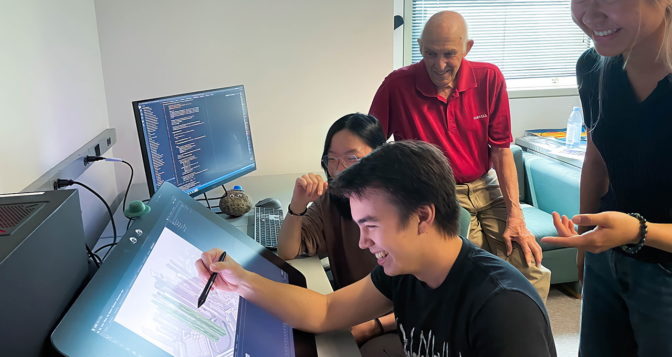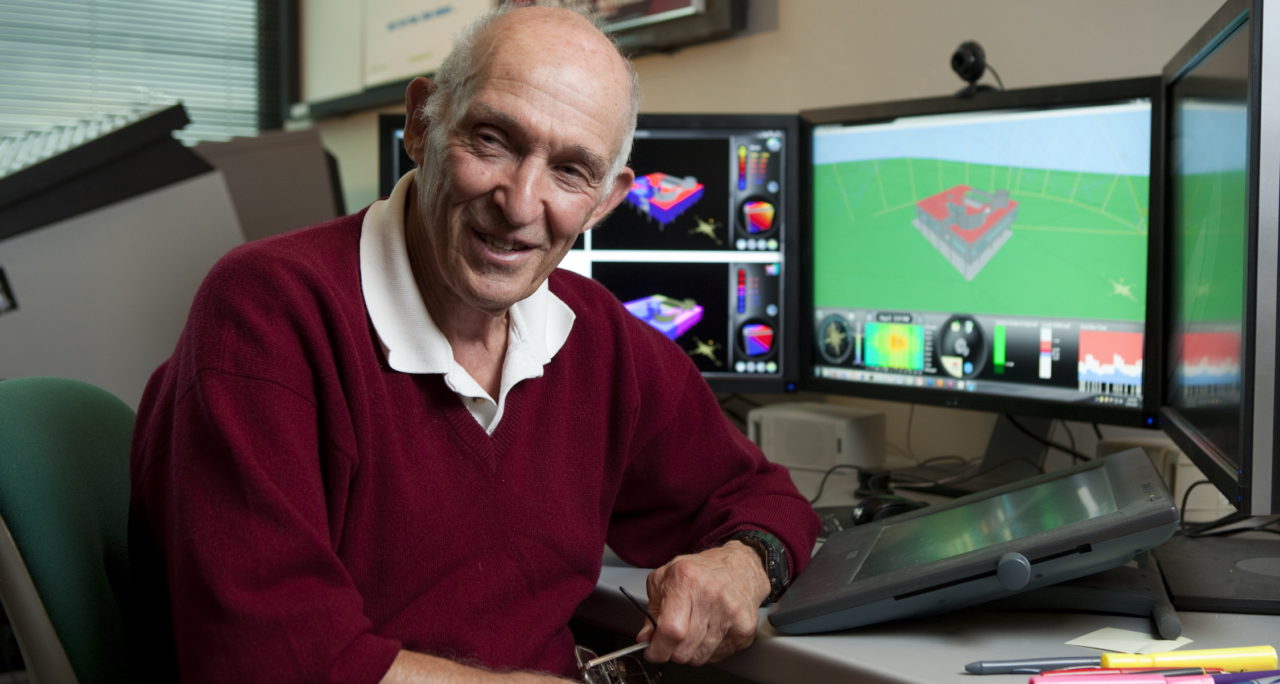Asked about the future of design, Donald Greenberg holds up a model of a human aorta.
“After my son became an intravascular heart surgeon at the Cleveland Clinic, he hired one of my students to use CAT scans and create digital 3D models of an aortic aneurysm,” said the computer graphics pioneer in a video interview from his office at Cornell University.
The models enabled custom stents that fit so well patients could leave the hospital soon after they’re inserted. It’s one example Greenberg gives of how computer graphics are becoming part of every human enterprise.
A Whole New Chapter
Expanding the frontier, he’s creating new tools for an architecture design course based on today’s capabilities for building realistic 3D worlds and digital twins. It will define a holistic process so everyone from engineers to city planners can participate in a design.
The courseware is still at the concept stage, but his passion for it is palpable. “This is my next big project, and I’m very excited about it,” said the computer graphics professor of the work, which is sponsored by NVIDIA.
“NVIDIA is superb at the hardware and the software algorithms, and for a long time its biggest advantage is in how it fits them together,” he said.
Greenberg imagines a design process open enough to include urban planners concerned with affordable housing, environmental activists mindful of sustainable living and neighbors who want to know the impact a new structure might have on their access to sunlight.
“I want to put people from different disciplines in the same foxhole so they can see things from different points of view at the same time,” said Greenberg, whose courses have spanned Cornell’s architecture, art, computer science, engineering and business departments.
Teaching With Omniverse
A multidisciplinary approach has fueled Greenberg’s work since 1968, when he started teaching at both Cornell’s colleges of engineering and architecture. And he’s always been rooted in the latest technology.
Today, that means inspiring designers and construction experts to enter the virtual worlds built with photorealistic graphics, simulations and AI in NVIDIA Omniverse.
“Omniverse expands, to multiple domains, the work done with Universal Scene Description, developed by some of the brightest graphics people at places like Pixar — it’s a superb environment for modern collaboration,” he said.
It’s a capability that couldn’t have existed without the million-X advances in computing Greenberg has witnessed in his 54-year career.
He recalls his excitement in 1979 when he bought a VAX-11/780 minicomputer, his first system capable of a million instructions per second. In one of his many SIGGRAPH talks, he said designers would someday have personal workstations capable of 100 MIPS.
Seeing Million-X Advances
The prediction proved almost embarrassingly conservative.
“Now I have a machine that’s 1012 times more powerful than my first computer — I feel like a surfer riding a tidal wave, and that’s one reason I’m still teaching,” he said.

It’s a long way from the system at General Electric’s Visual Simulation Laboratory in Syracuse, New York, where in the late 1960s he programmed on punch cards to help create one of the first videos generated solely with computer graphics. The 18-minute animation wowed audiences and took him and 14 of his architecture students two years to create.
NASA used the same GE system to train astronauts how to dock the Apollo module with the lunar lander. And the space agency was one of the early adopters of digital twins, he notes, a fact that saved the lives of the Apollo 13 crew after a system malfunction two days into their trip to the moon.
From Sketches to Digital Twins
For Greenberg, it all comes down to the power of computer graphics.
“I love to draw, 99% of intellectual intake comes through our eyes and my recent projects are about how to go from a sketch or idea to a digital twin,” he said.
Among his few regrets, he said he’ll miss attending SIGGRAPH in person this year.
“It became an academic home for my closest friends and collaborators, a community of mavericks and the only place I found creative people with both huge imaginations and great technical skills, but it’s hard to travel at my age,” said the 88-year-old, whose pioneering continues in front of his computer screen.
“I have a whole bunch of stuff I’m working on that I call techniques in search of a problem, like trying to model how the retina sees an image — I’m just getting started on that one,” he said.
—————————————————————————————————————————————————
Learn More About Omniverse at SIGGRAPH
Anyone can get started working on digital twins with Omniverse by taking a free, self-paced online course at the NVIDIA Deep Learning Institute. And individuals can download Omniverse free.
Educators can request early access to the “Graphics & Omniverse” teaching kit. SIGGRAPH attendees can join a session on “The Metaverse for International Educators” or one of four hands-on training labs on Omniverse.
To learn more, watch NVIDIA’s CEO Jensen Huang and others in a special address at SIGGRAPH on-demand.
